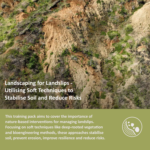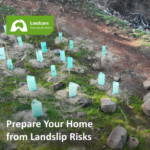Mitigating Landslips with Nature-Based Strategies
“Landslide” and “landslip” are often used interchangeably, though technically, a landslip refers to slow, continuous movement over time, while a landslide indicates a sudden event. For consistency, throughout this project we will use “landslip” to refer to both terms.
Landslips are a serious environmental hazard, which pose significant risks including loss of life, damage to property and infrastructure, and environmental degradation, particularly in areas with steep terrain and heavy rainfall.
Landslips are primarily dealt with through engineering solutions such as retaining walls, drainage systems, and slope stabilisation techniques. These methods aim to control water flow and reinforce vulnerable slopes, often relying on retaining walls or other large earthwork strategies.
These strategies, while effective, can often be highly expensive and may not be an option for some landholders. Advice from qualified soil technicians should always be sought on landslip sites.
In recent decades, nature-based solutions have been incorporated to manage landslip risks either in conjunction with traditional stabilisation methods or in instances where large earthworks can not be undertaken due to cost or access factors. Landcare NSW is using strategies like reforestation, the restoration of native vegetation, and bioengineering techniques to mitigate and manage landslip and erosion risks.
Understanding Landslips
Understanding landslips and risk factors is crucial for being able to effectively mitigate any associated risks.
A landslide is a geological event where a mass of rock, earth, or debris moves down a slope. This can be gradual or a sudden event. Landslips are often triggered by factors such as:
- heavy rainfall
- earthquakes
- volcanic activity
- human activities like deforestation and construction.
- Intensive farming, agricultural practices or poor land management
Identifying high-risk areas and creating comprehensive risk mitigation plans are essential steps in preparing your property for fires. There are also building codes, vegetation management rules, and land use planning requirements. It’s important to consult with local fire authorities or councils for tailored advice and to ensure compliance with local regulations.
Problems and impacts caused by landslips
The risks associated with landslips include:
Loss of life and injury: Sudden landslides can trap or bury people, leading to fatalities and serious injuries.
Damage to infrastructure: Roads, bridges, railways, and buildings can be destroyed or severely damaged, disrupting transportation and communication networks.
Property destruction: Homes and businesses located in landslide-prone areas can be destroyed, leading to financial losses and displacement of residents.
Economic impact: The costs of repairing damaged infrastructure, compensating for property loss, and managing emergency response can be substantial.
Environmental degradation: Landslides can strip vegetation, disrupt ecosystems, and cause soil erosion, leading to long-term ecological changes.
Loss of biodiversity: Landslips can destroy habitats, displace wildlife, and disrupt ecosystems, leading to a decline in plant and animal species in the immediate affected area.
Water supply contamination: Landslides can affect water quality by introducing debris and sediment into rivers, reservoirs, and water treatment facilities.
Increased vulnerability to future events: Subsequent weather events, such as heavy rains, can exacerbate existing landslip areas, leading to recurring problems.
Recognising landslip risk factors
Recognising the risk factors of landslides is essential for effective planning and mitigation strategies to protect lives, property, and infrastructure. Some common risk factors in NSW include:
Heavy rainfall events and cyclones: Particularly in regions like the east coast of Australia, which can lead to rapid soil saturation and increased runoff.
Bushfires: These can destabilise slopes by removing vegetation that anchors the soil, increasing the risk of landslides during subsequent rainfalls.
Soil composition and geological conditions: Areas with fragmented, pourous or weathered rock formations are more susceptible to landslides.
Topography: Steep terrains and escarpments, commonly found in mountainous regions and coastal cliffs, are prone to landslides.
Land use practices: Deforestation, urban development, and agriculture can disturb the land and increase erosion and instability.
Water concentration: there is a tendency for erosion risk and a chance of slips.
Climate change: Changing weather patterns, including more intense and frequent rainfall, exacerbate the risk of landslips.
Prehistoric Landslips: These masses can be reactivated by construction activities, heavy rainfall, and earthquakes.
Downloadable Bush Fire Training Pack & Worksheets

Landscaping for Landslips – Utilising Soft Techniques to Stabilise Soil and Reduce Risks
This training pack aims to cover the importance of nature-based interventions for managing landslips. Focusing on soft techniques like deep-rooted vegetation and bioengineering methods, these approaches stabilise soil, prevent erosion, improve resilience and reduce risks.
Download: Landslips Training Pack

Prepare Your Home from Landslip Risks
After completing the training pack, you should take several steps to protect your property from landslips.
Download: Landslips Worksheet
Landslip Videos
In this comprehensive guide by Landcare NSW People Led Prevention project, we delve into effective strategies for landslip restoration and prevention. From utilising drone seeding and earth-moving machinery to harnessing nature’s power with specific plant species, this video covers a range of large-scale and low-cost solutions.
Discover the inspiring story of Landcare’s dedication to helping landowners rebuild and re-empower themselves after a devastating landslip disaster. Through the power of community, nature-based solutions and land management techniques, see how Landcare’s approach has made a significant impact in restoring the land and preparing for future challenges.
Other Disaster Resources
Helpful Resources
Flood Information & Warning Systems
NSW Government – Floods in NSW
Local Land Services roles in Floods
Bureau of Meteorology – NSW Warnings Summary
Hazards Near Me NSW Mobile App
Risk Assessment & Planning
NSW Government – Flood Risk Management Manual
Local Land Services – Farm Flood Readiness Kit
Local Land Services – Riparian & In-stream Works Community Guildeline
Managing Erosion
Local Land Services – Managing Erosion Before & After Floods
Riparian Restoration
NSW Government – Good Practices in Riparian Rehabilitation
Sustainable Farms – Riparian Restoration
Soil Conservation Service – Case Study: Post flood riparian rehabilitation on the Tweed River
Rivers of Carbon – How Restoring Rivers Builds Flood Resilience
Great Rivers Greenway – Recommendations for Stream-bank Planting
Local Land Services Revegetation Tips and Tricks
Flood Planting Guides
NSW Government – The Long-stem Planting Guide
Land for Wildlife South East QLD – Propagating Lomandras
Great Rivers Greenway – Recommendations for Stream-bank Planting
Fencing, Land Works & Healthy Soil
Stock & Waterways – Riparian Fencing
Bellinger Landcare – The Bellinger River system Landholder Booklet
Soil Conservation Service – Post flood Riparian Rehabilitation on the Tweed River
Risk Frontiers – Nature-based Flood Mitigation Strategies
Local Land Service – What is a Healthy Soil?
Shoalhaven Riverwatch – Sand Sausages on the Shoalhaven River
For Urban Areas
City of Sydney – What is a Raingarden?
Cool Compost Podcast – How compost can deliver circular solutions for councils